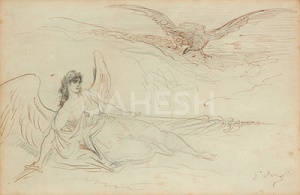Gustave Doré (French, 1832–1883)
Study for The Black Eagle of Prussia, 1870-71
Graphite, black and brown ink on off-white wove paper, 9 5/8 x 14 1/8 in.
Signed lower right: G. Doré
2014.2

This sheet by Gustave Doré, the most recent addition to the Museum’s substantial drawing collection, is of particular interest because it is a study for an important painting in the Museum collection. The Black Eagle of Prussia is one of three monumental canvases the artist painted in 1870–71, when Prussia defeated France and civil war broke out in Paris. One of three known studies for the painting, it most likely documents Doré’s first idea for the subject. With rapidly executed strokes, Doré determines the general composition: a defeated and prostrate France, embodied by a winged woman wearing a robe and Phrygian bonnet, clutching a broken sword and standard, is threatened by an ominous black eagle, the emblem of Prussia. The drawing differs in several areas from the finished painting, which adds fallen battlefield soldiers and enlarges the size of the bird in relation to the figure.
This is the fourth work by the artist to enter the collection.


